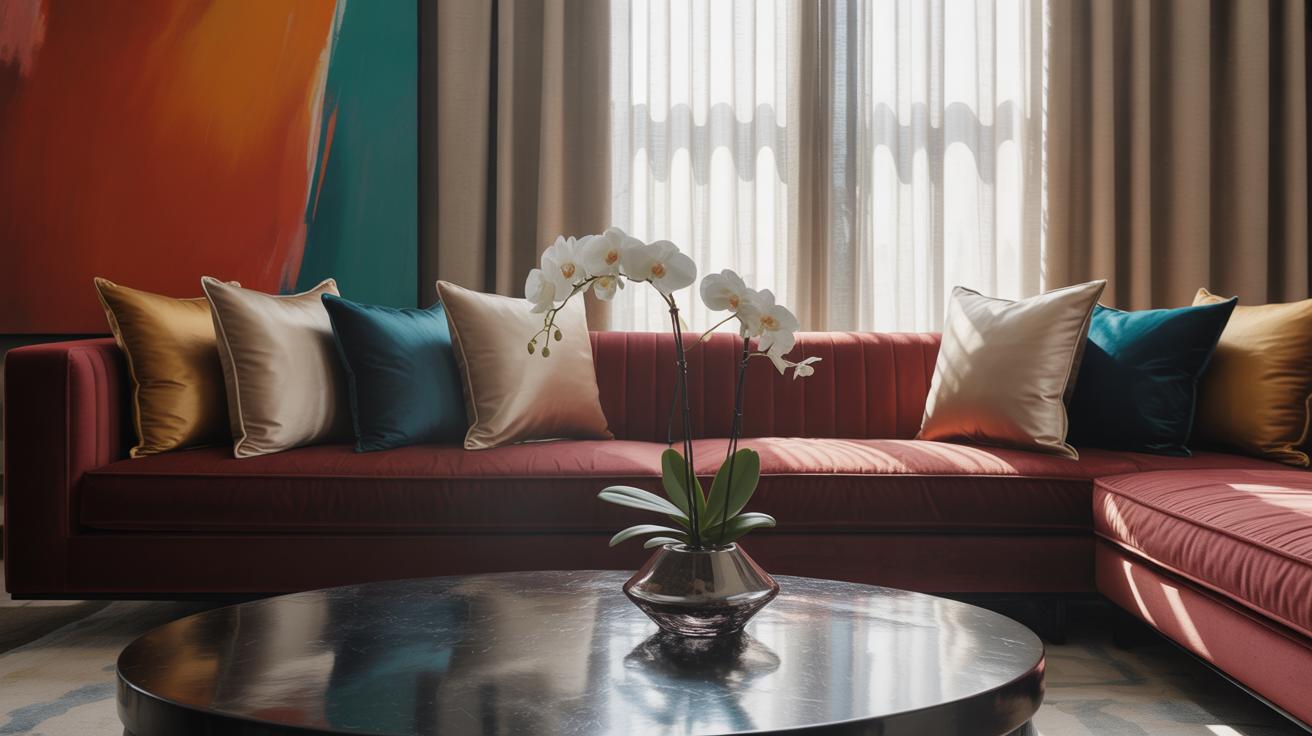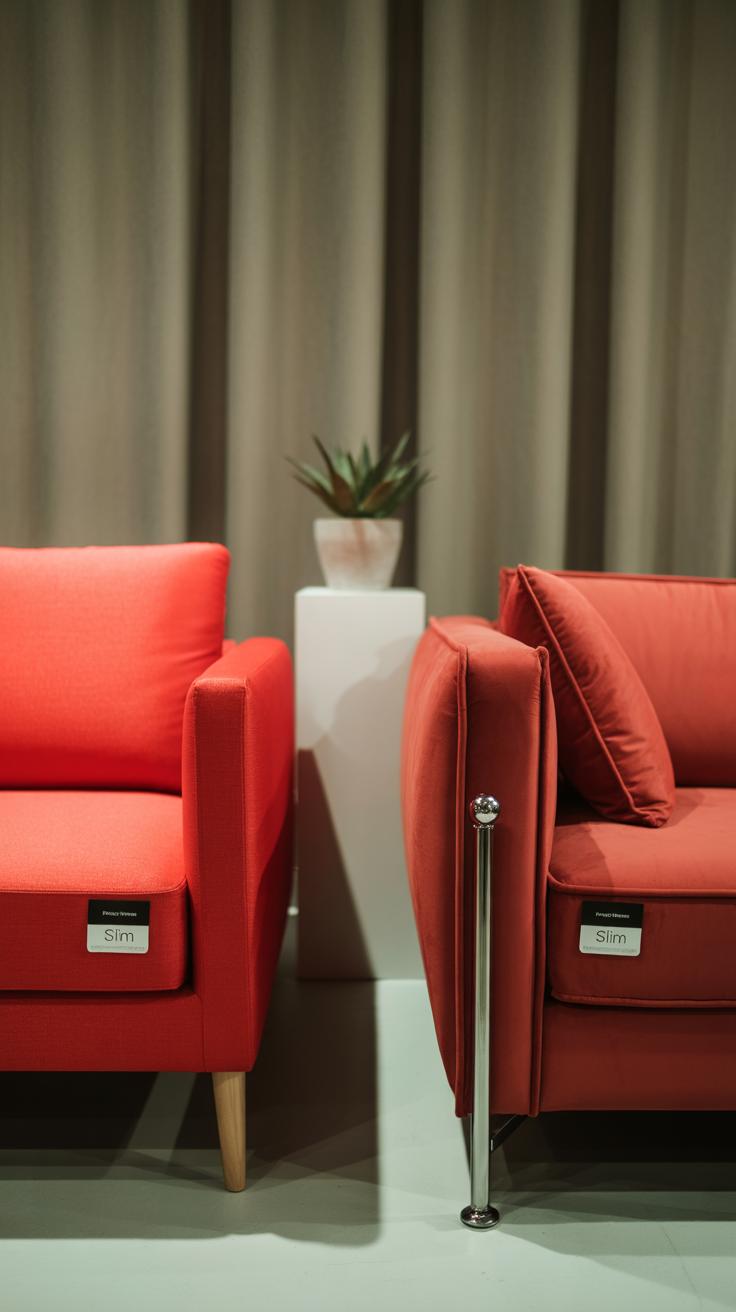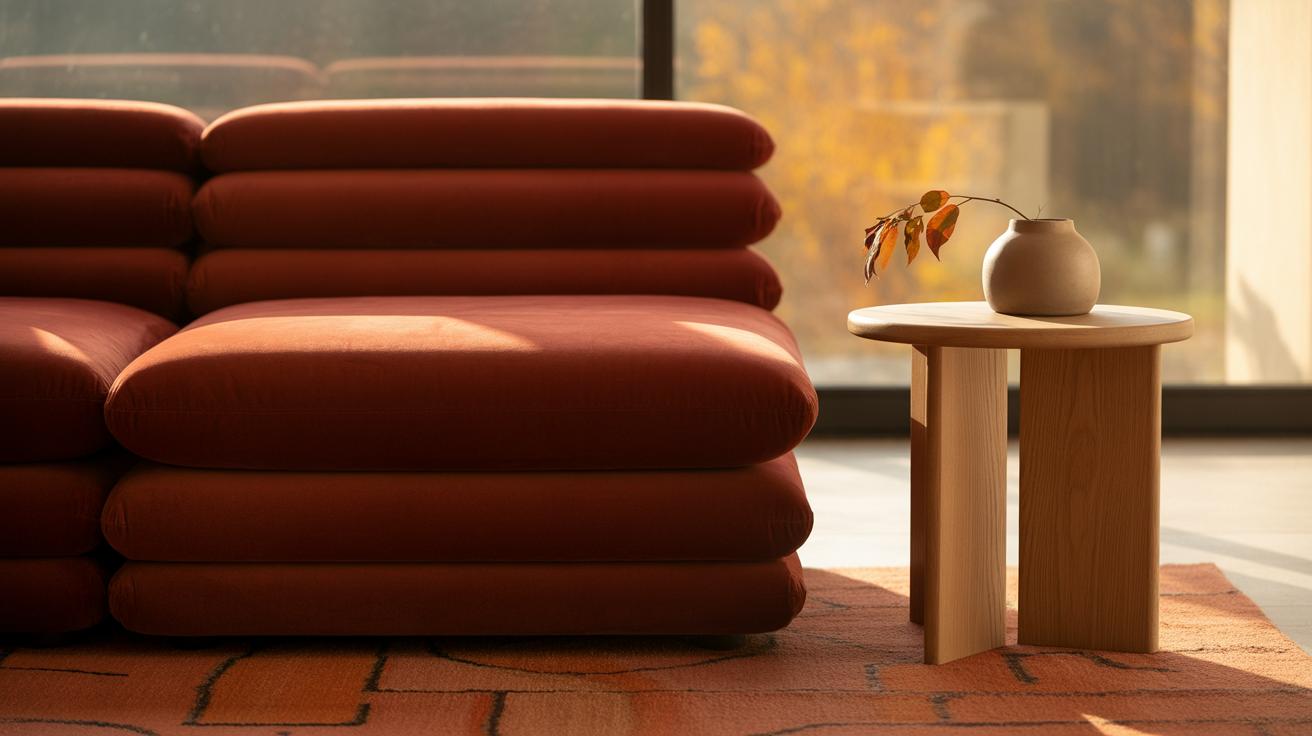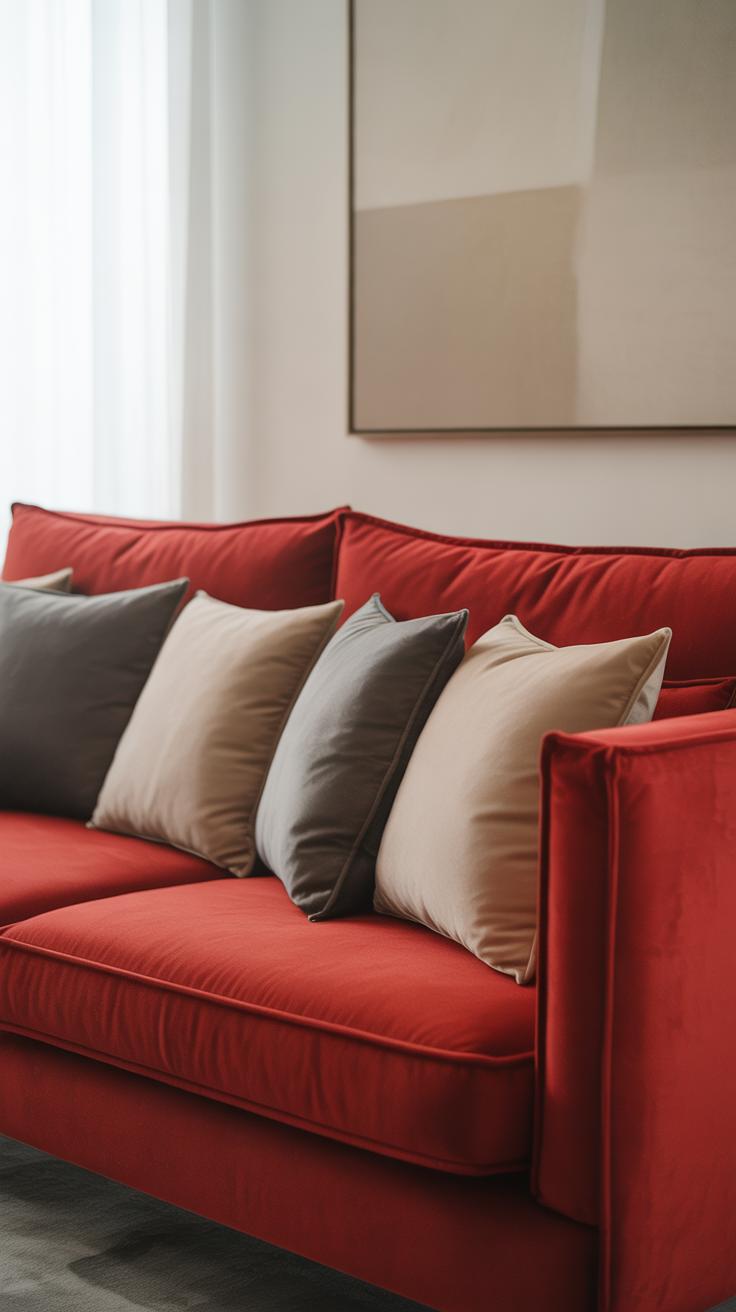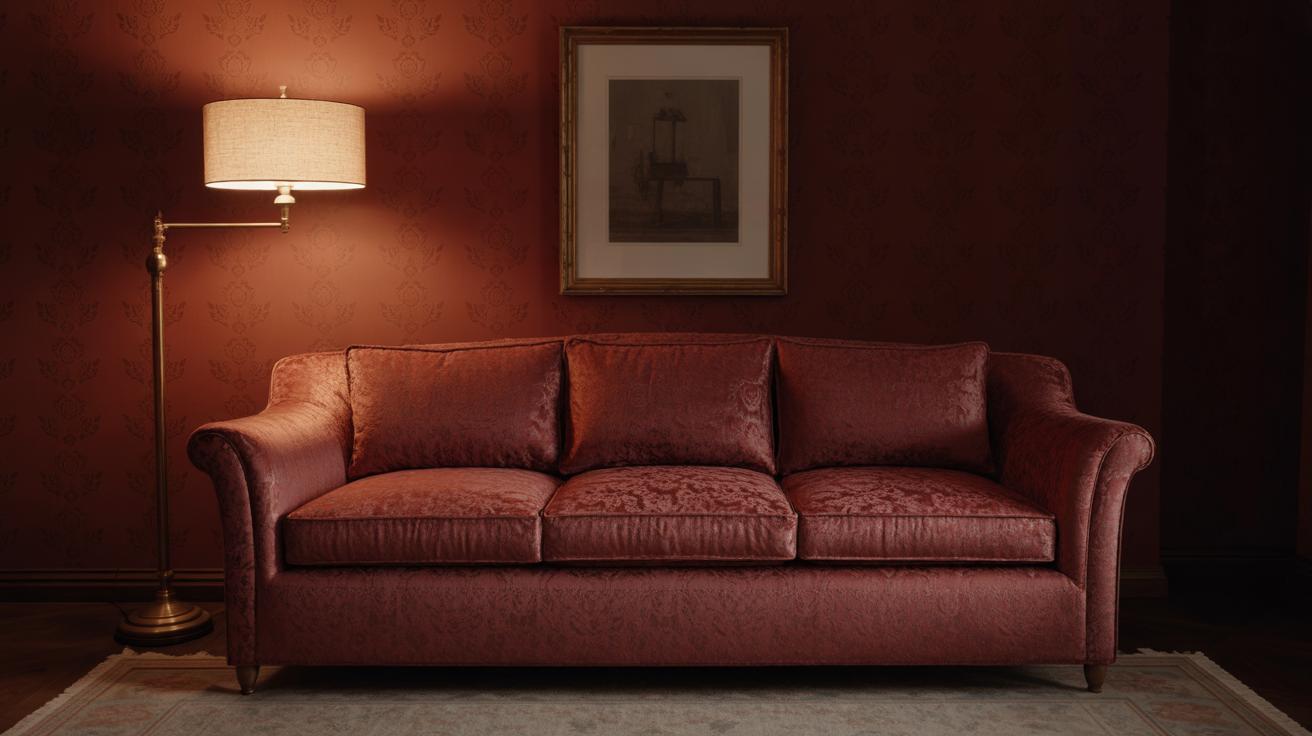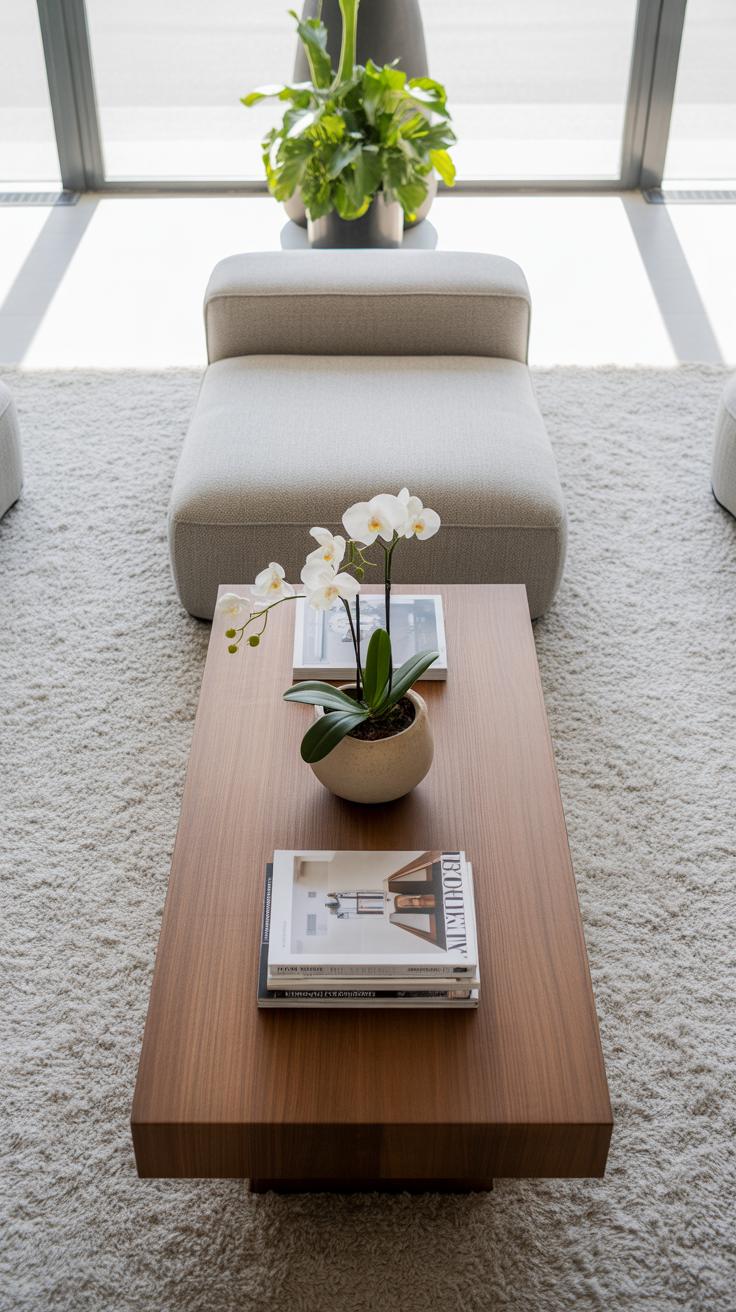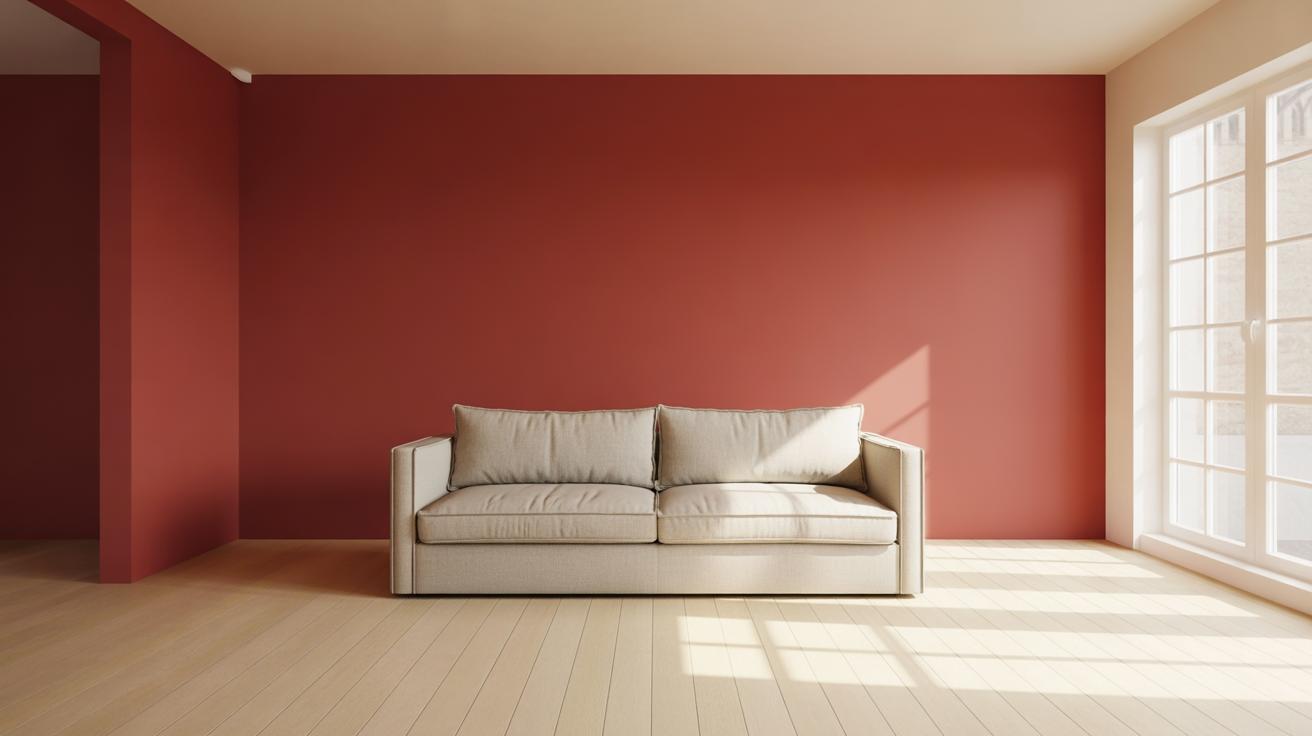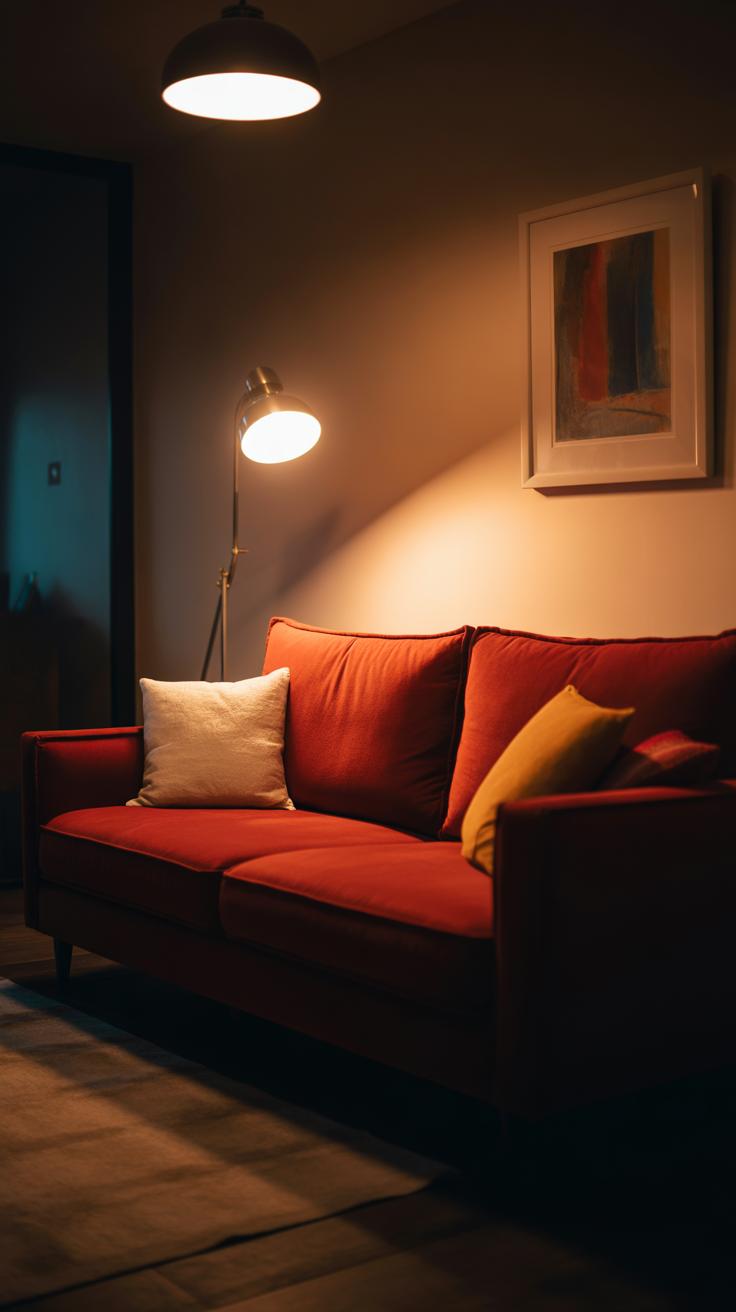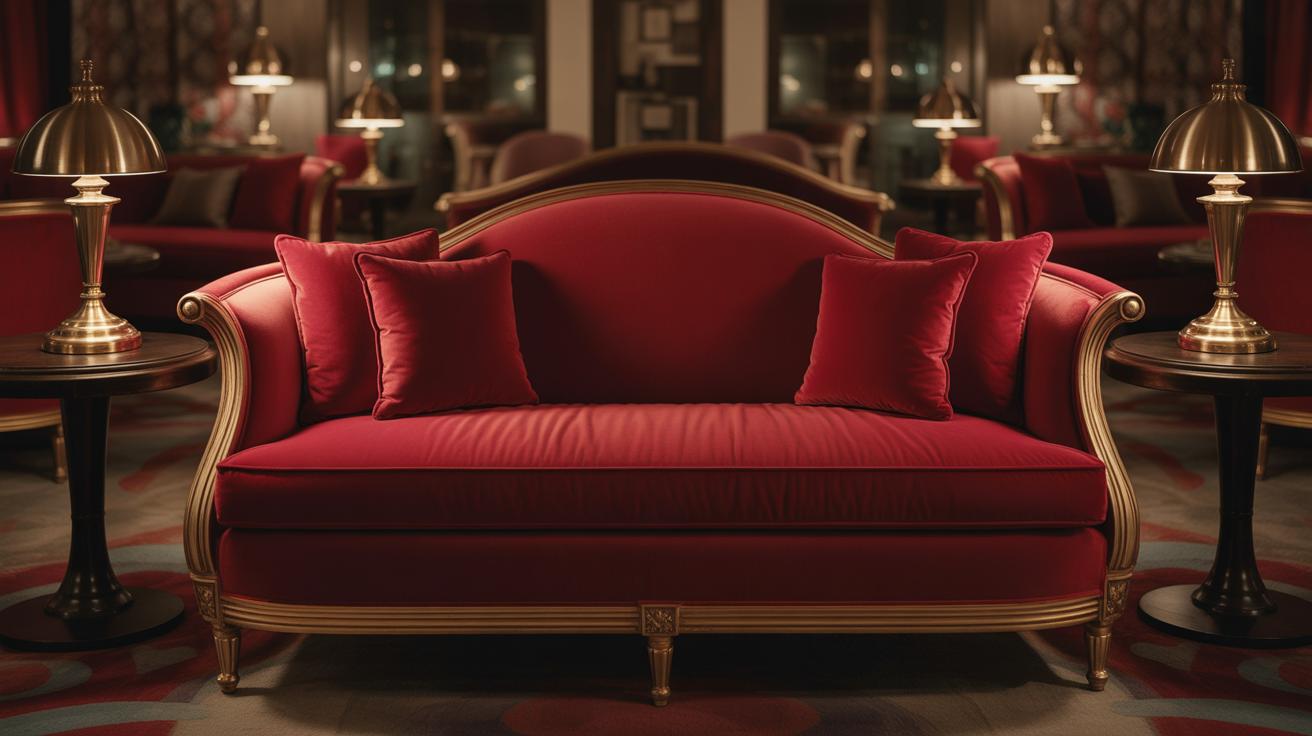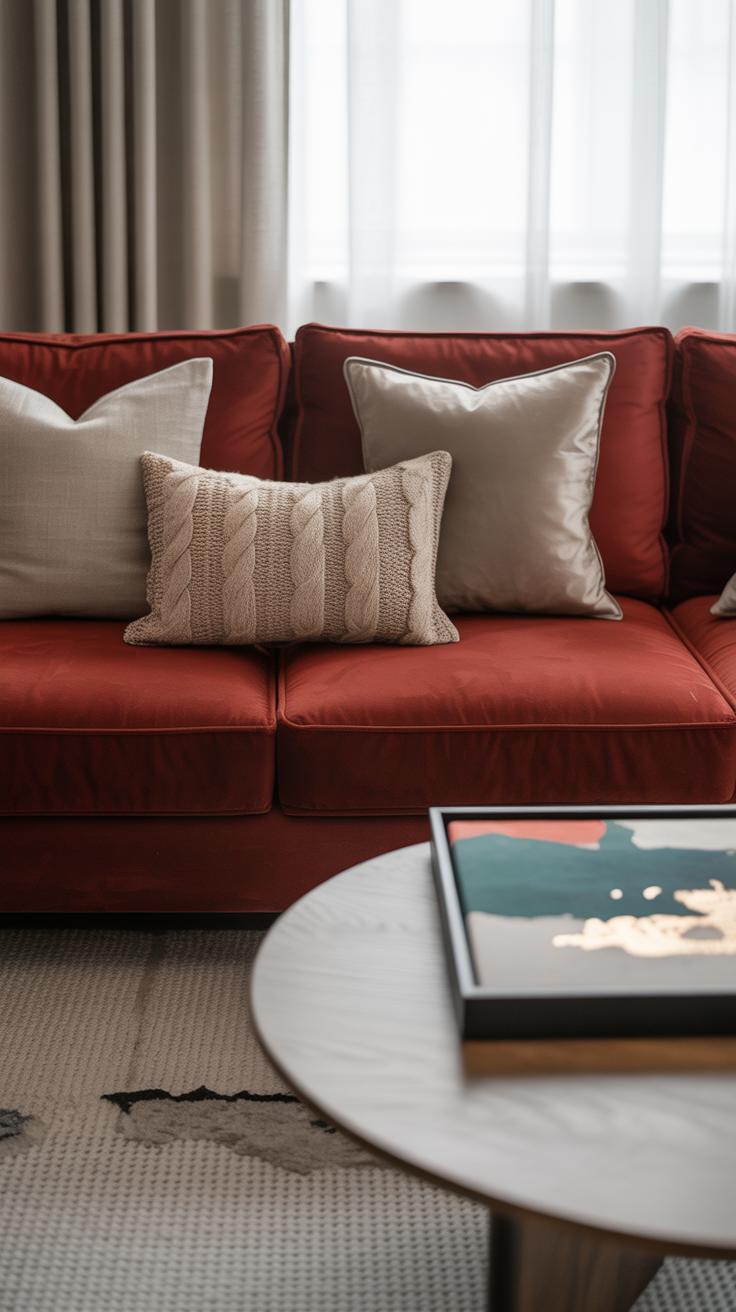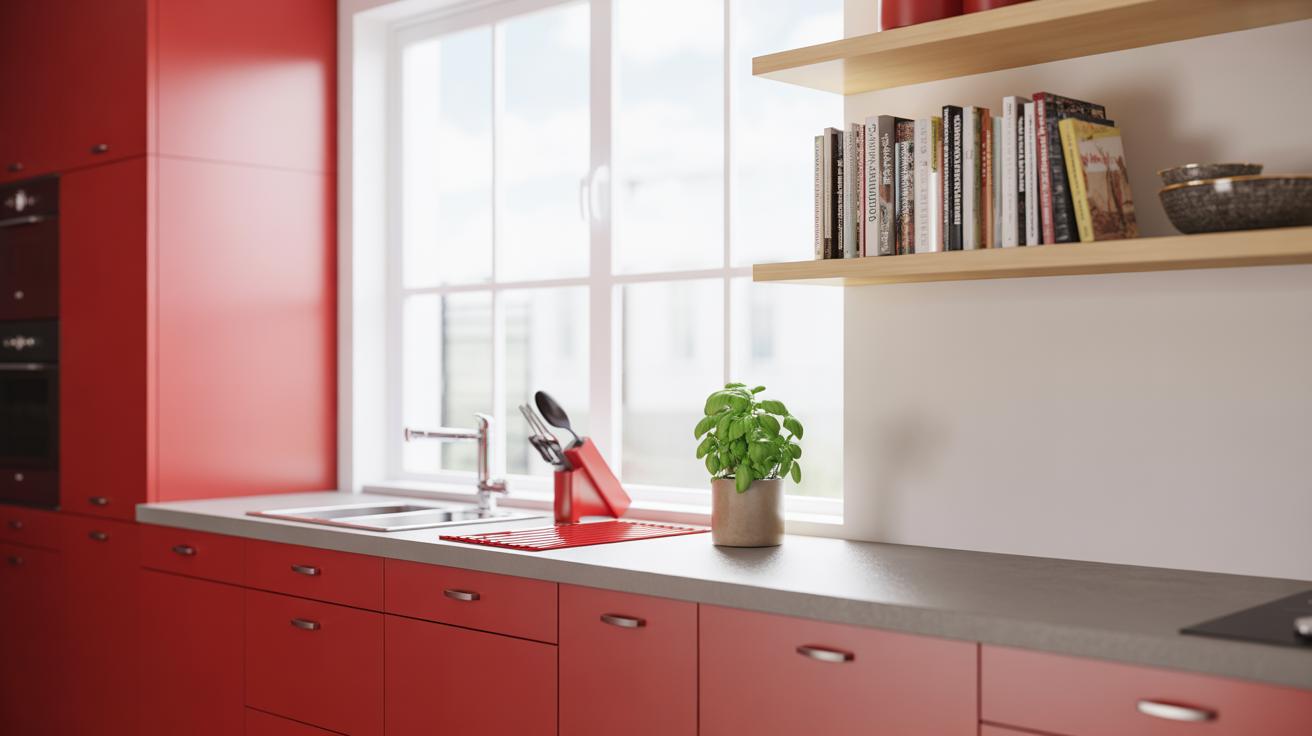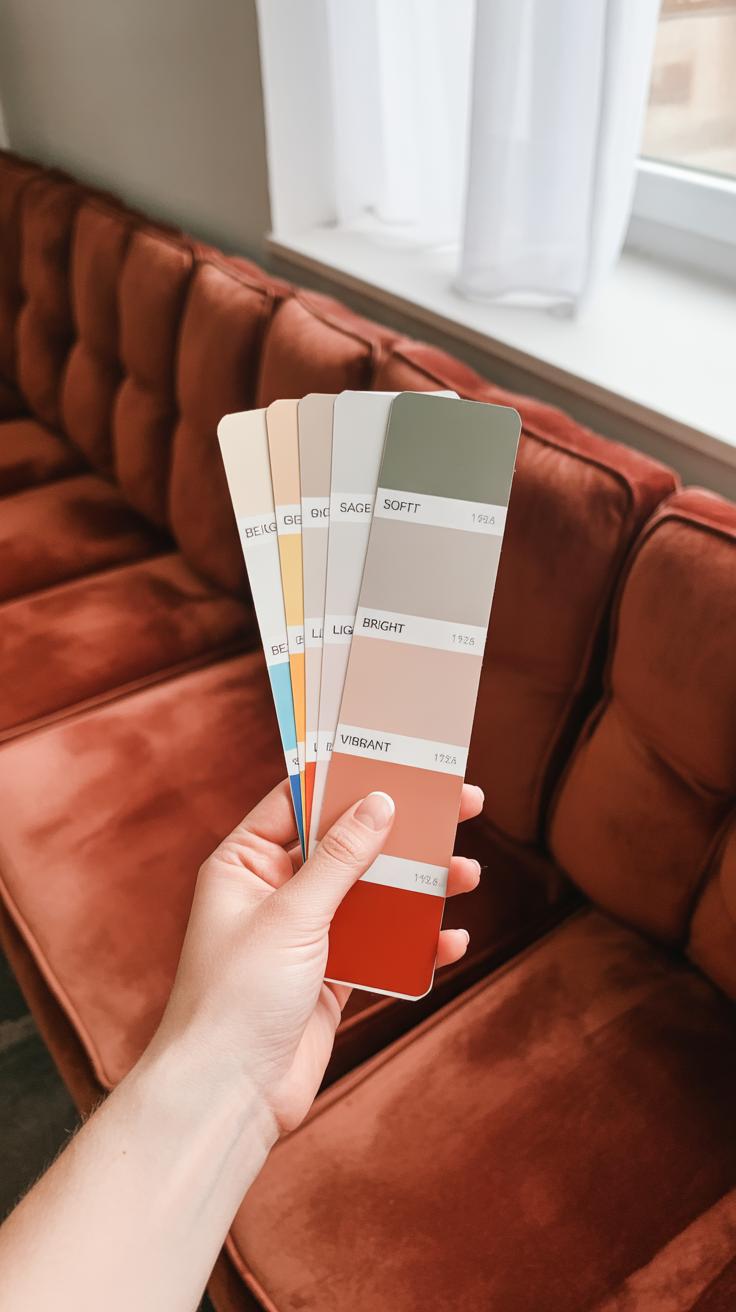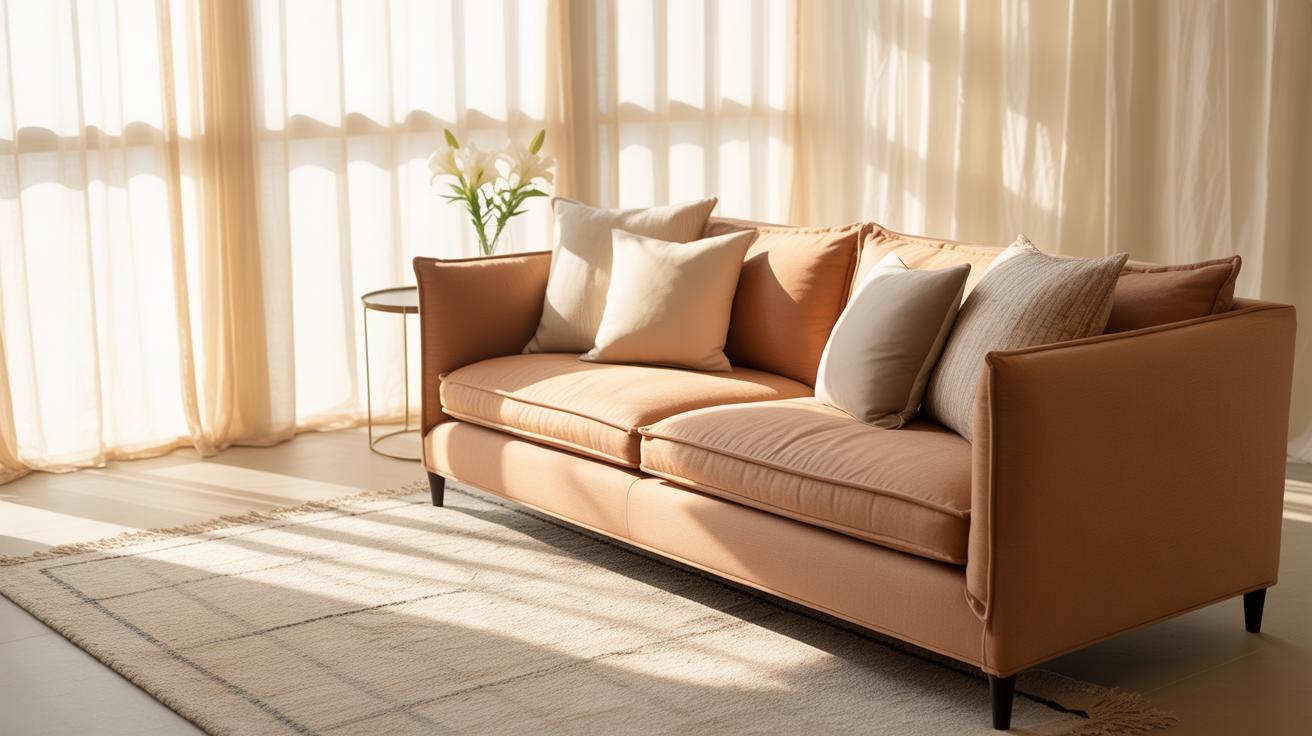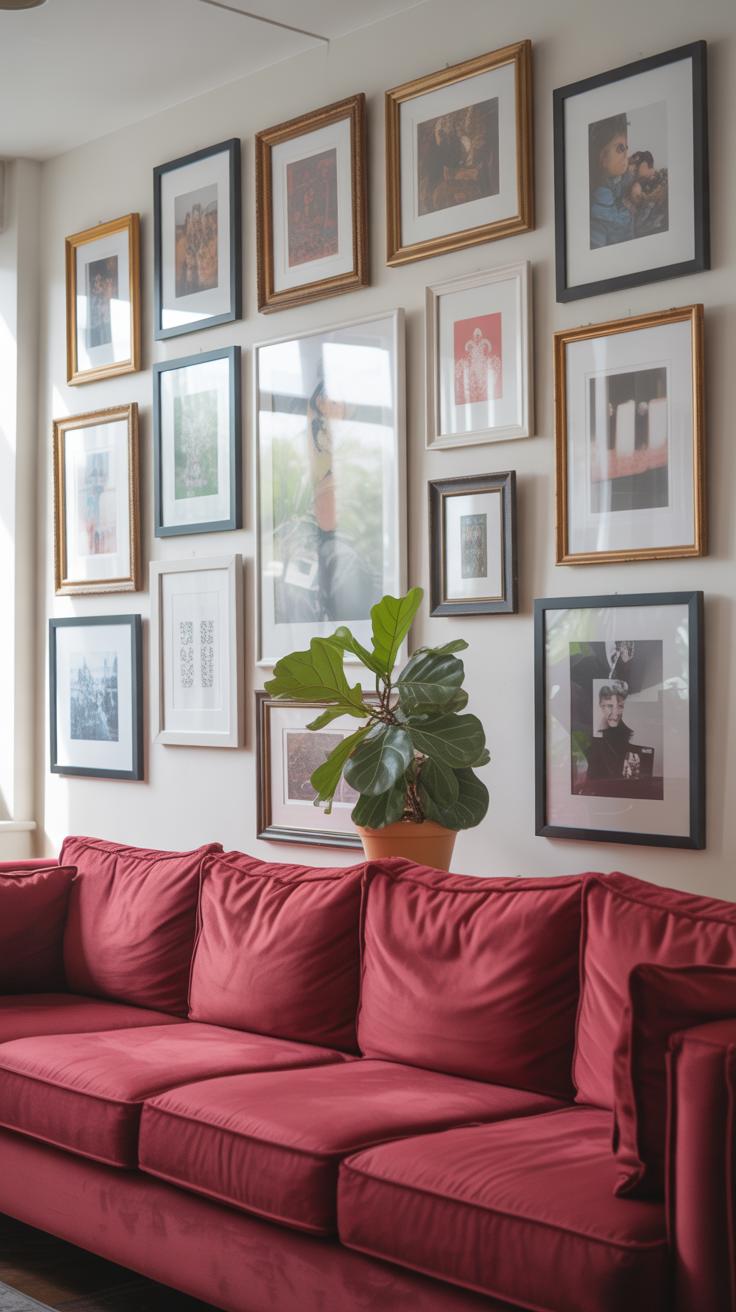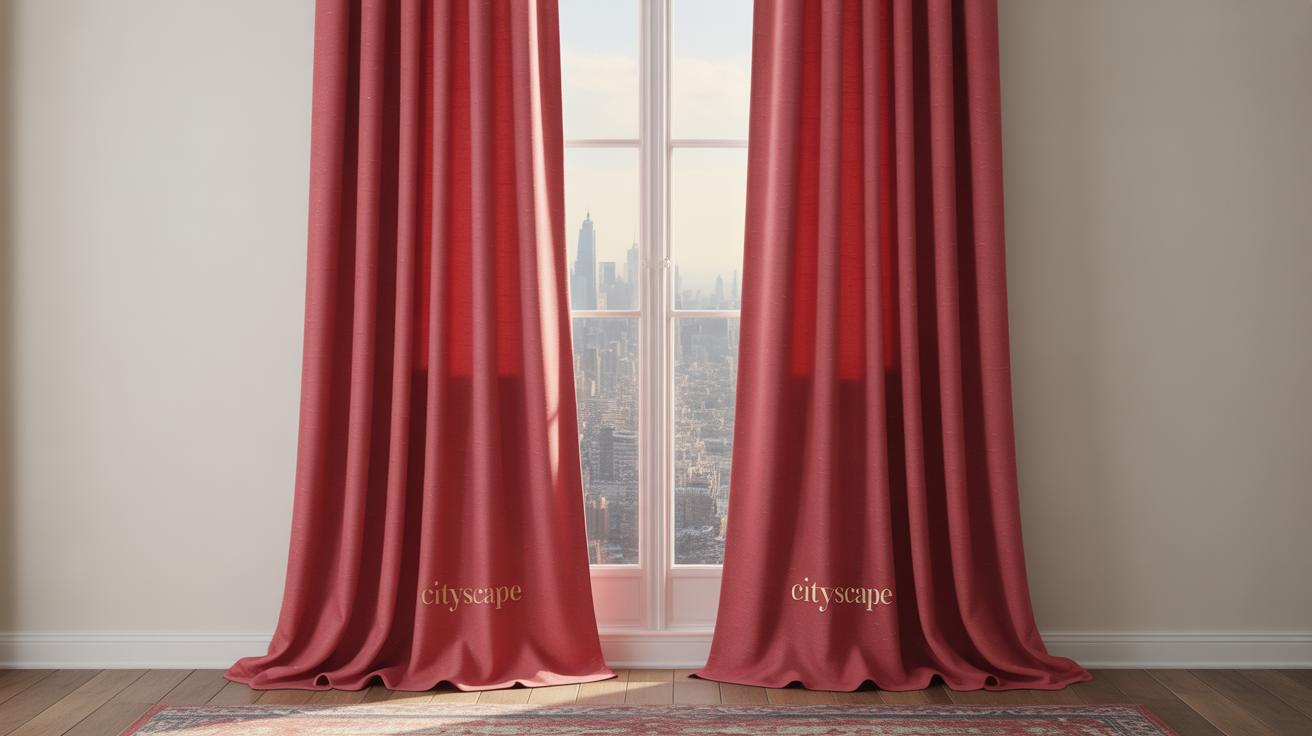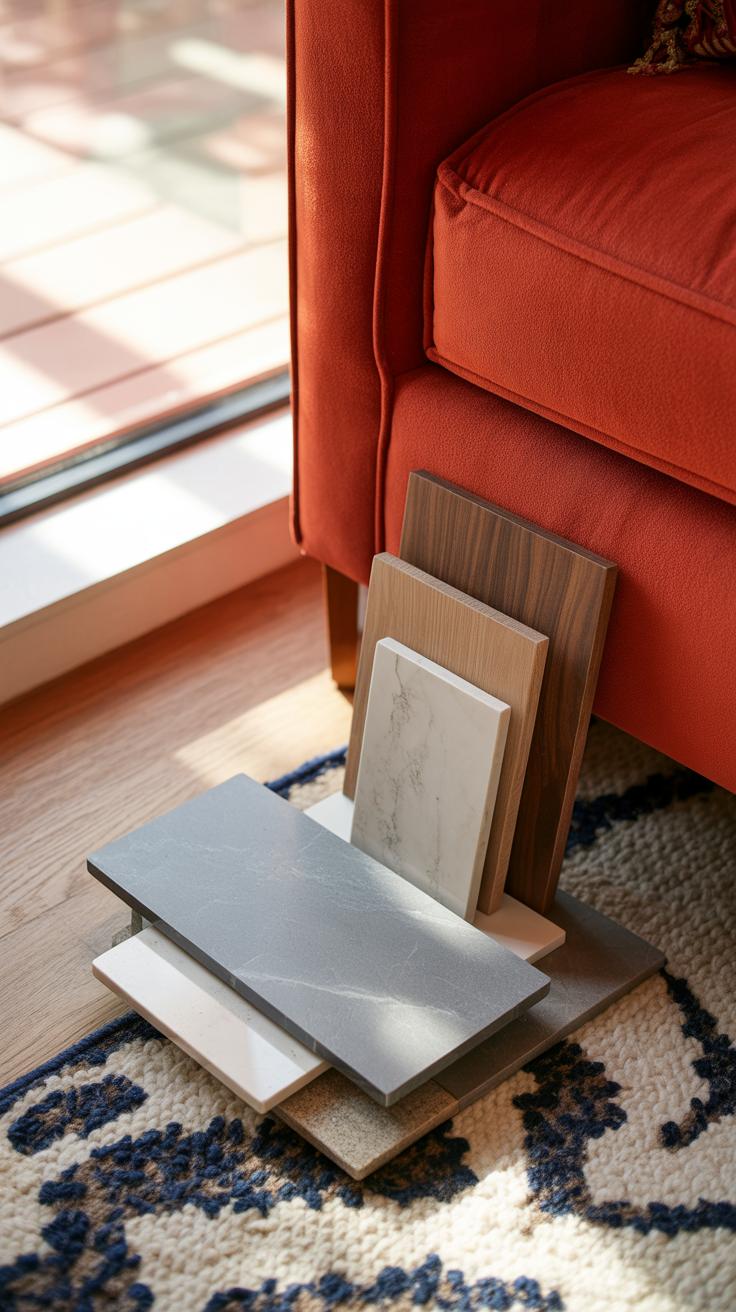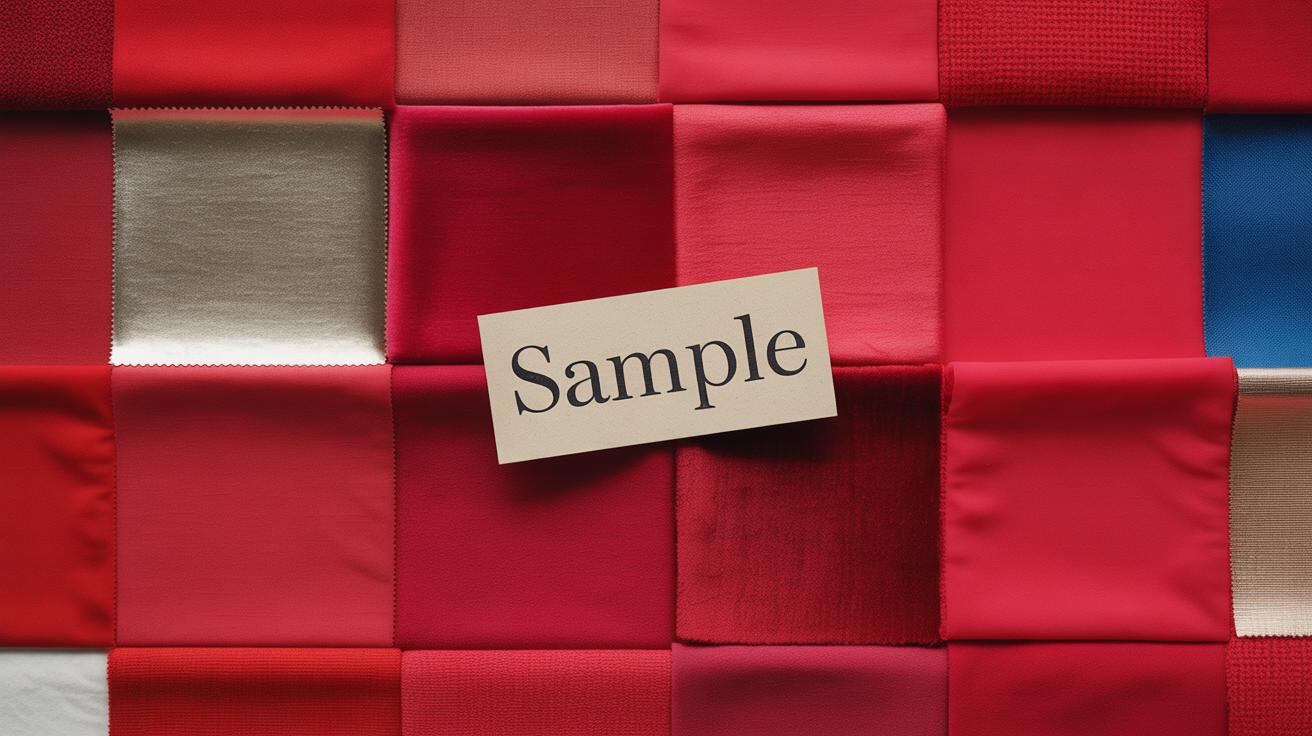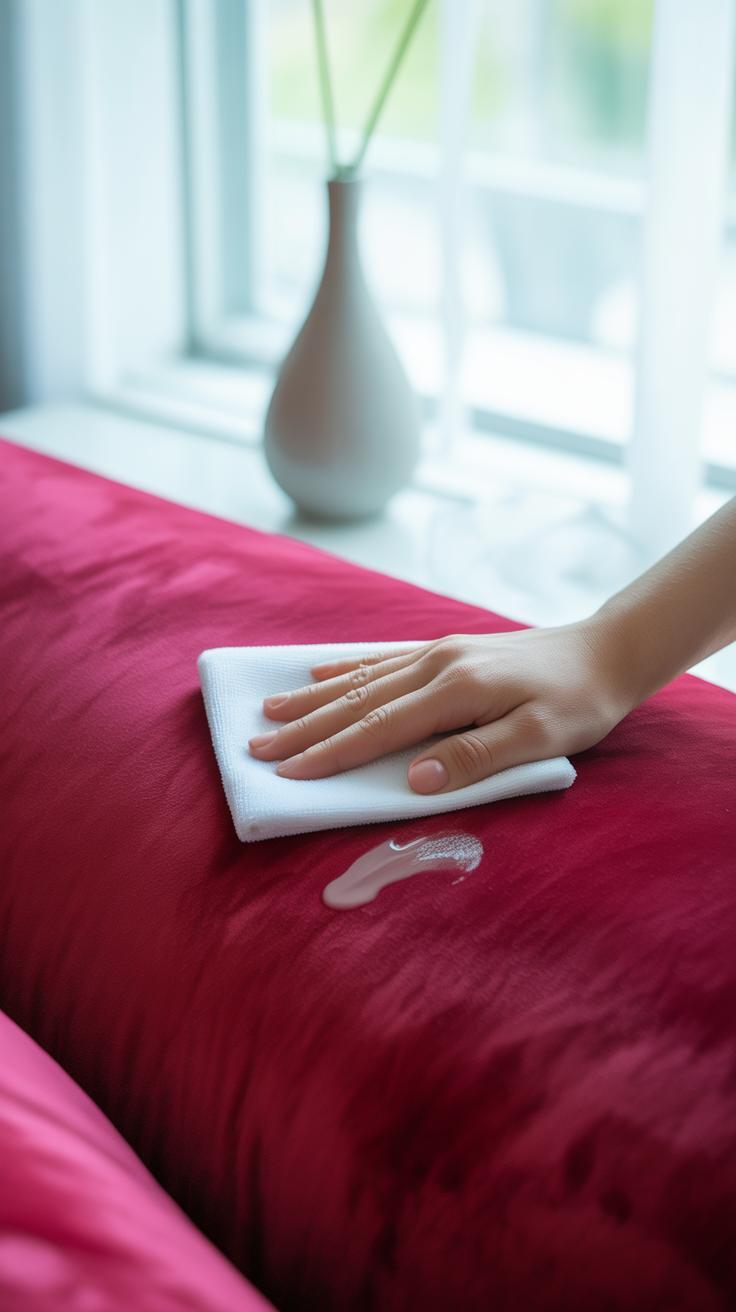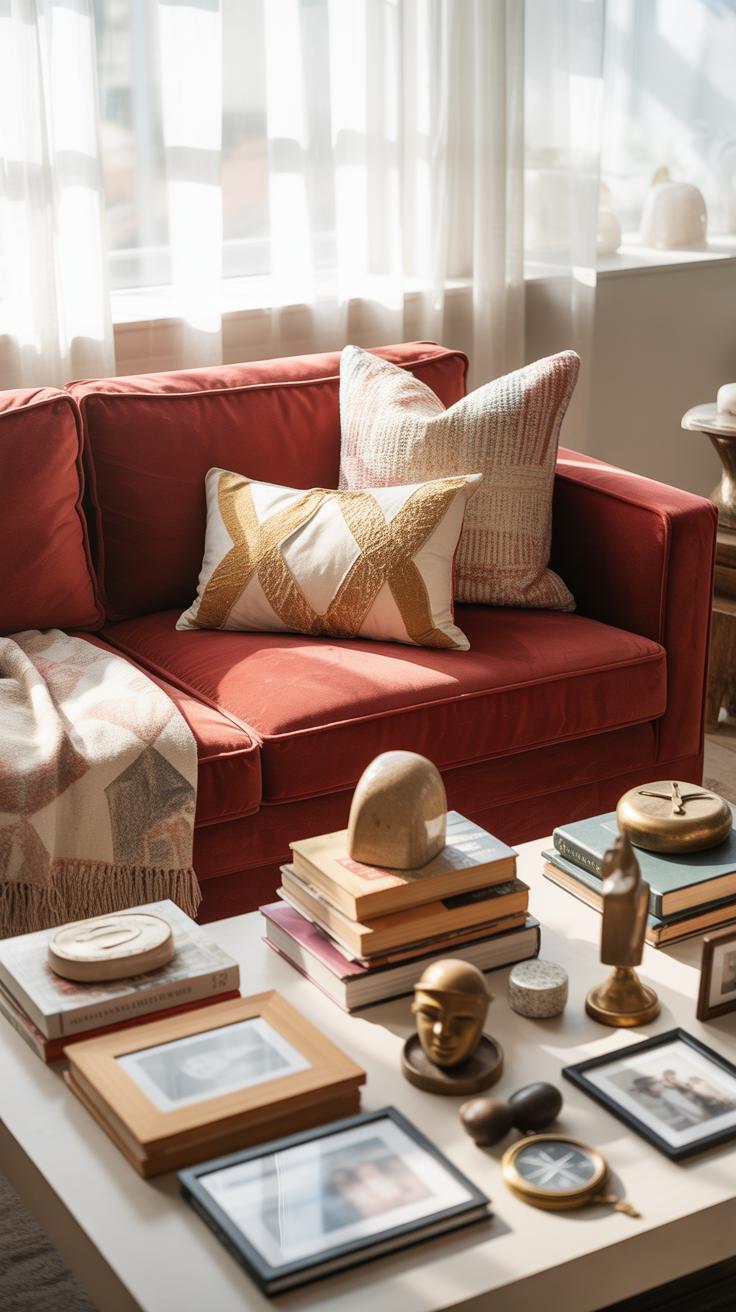Introduction
A red couch adds a bold splash of color to your living room. It’s a furniture piece that catches the eye right away and can become the heart of your space. With the right ideas, your red couch can look polished and inviting.
This article explores ways to style a red couch in your living room, including decorating tips, color pairings, and practical advice. You’ll find ideas you can use to make your living room feel warm, stylish, and comfortable.
Selecting Your Red Couch
Understanding Red Shades
Red comes in many tones—there’s cherry, crimson, burgundy, rust, even scarlet. Each shade changes how the room feels. Bright reds can energize a space, but might overwhelm a small or dimly lit room. Deeper reds, like burgundy or wine, tend to feel cozier and more subdued, which might suit a room used for relaxing or entertaining. If your living room gets little natural light, picking a darker red might make it feel cramped, while lighter or brighter reds can help open it up. Think about your personal style too—are you drawn to bold, statement reds or softer, almost muted shades? Your choice affects everything else in the room, so it pays to imagine the couch at different times of day.
Picking the Right Fabric
Fabric choice impacts not just look, but daily life. Velvet red couches bring a touch of luxury and richness, but they can show wear more quickly and need gentle cleaning. Leather feels sleek and ages well, developing character, yet it can feel cold and less inviting in cooler months. Cotton or linen-like fabrics are comfy and breathable, though they might stain easier and wrinkle faster. Durability matters if you have kids or pets—think how often you want to clean or replace the couch. Also, some fabrics fade under bright sunlight, which is worth considering if your living room has large windows or a sunny orientation.
Size and shape matter as much as color and fabric. In a narrow or small room, a bulky red sofa might crowd the space and make it look smaller. Opt for streamlined or mid-century modern styles with exposed legs to keep the room feeling open. Large, open rooms can handle a big, plush red couch—maybe even sectional styles—that act as a focal point without overwhelming. Think about the flow in the room and where you want people to gather. Sometimes, a smaller red accent chair paired with neutral sofas works better than a massive red couch.
Red Couch and Color Harmony
Working with a red couch means you’re starting from a strong visual point, so the colors around it need careful thought. If you feel a bit unsure about mixing colors, it might help to break down options into complementary, analogous, and neutral palettes.
Complementary colors—think of shades opposite red on the color wheel like soft greens—add contrast without overwhelming. They can create a fresh balance but using too much green can feel a bit much. Maybe a pale mint cushion here or a few olive details there, rather than a whole wall, works better for most rooms.
Analogous colors, like oranges and deep pinks, naturally flow with red. These shades share warmth and look cozy together, yet they can run the risk of blending in too much—you don’t want the room to feel monochrome or flat.
Neutral colors are kind of your best friend with red. Whites, beiges, greys, and blacks help to soften the red’s intensity and give your eye somewhere to rest. For example, a light grey rug or white walls can pull focus gently from the couch, allowing it to stand out without shouting.
Bright accents also play a role in adding interest. Colors like mustard yellow, navy blue, or even cobalt can work well in small doses—throw cushions, a feature rug, or wall art. But the key is restraint; too many bright extras and it becomes chaotic. Try layering just a couple of these accents and see how the space feels—you might find less truly is more.
Furniture Arrangement with a Red Couch
When working with a red couch, one of the trickiest parts is figuring out how to arrange the other furniture so the room feels balanced—not too stark, but also not chaotic. Because red naturally draws the eye, it can easily dominate a space if you’re not careful. That said, placing the couch against a neutral or soft backdrop usually helps calm things down. For example, try positioning the red couch along a plain wall and then add chairs or a loveseat in muted tones across from it. This offsets the boldness without competing.
Think about creating a conversation area. Arrange seats to face each other or angled slightly inward. A round or oval coffee table in the center aids interaction, breaking lines of tension. It’s about inviting people into a natural flow, encouraging chats without forcing everyone to turn awkwardly towards the couch. Sometimes, layering a rug under just the seating area also anchors the space, making it feel more intimate despite the couch’s strong presence.
If your room is larger, you might worry the red couch will either look lost or overpower everything. One way is to add other substantial pieces—like a pair of armchairs, a sizeable floor lamp, or even a bookcase—to help fill the space. But keep those pieces fairly understated in color or design. Oddly enough, sometimes it’s better to leave some open space near the couch rather than clutter around it. This lets the couch breathe without the room feeling empty. You might find this balance depends on your furniture size and the room’s shape.
Have you ever felt a seating arrangement just didn’t encourage real conversation? Maybe it was too symmetrical or disconnected from the focal point—the red couch in this case. Try mixing up seats so people don’t sit in perfect rows or lines, but in a cozy cluster with differing angles and distances. Trust me, a bit of visual disorder can make conversations flow more naturally around the bold red centerpiece.
Lighting to Enhance Your Red Couch
Using Natural Light
Your red couch can really pop when bathed in natural light. Think about where your windows sit in the room and how sunlight moves throughout the day. Morning light often feels cooler and softer, which might make the red look a bit muted, while afternoon sunlight is warmer and can bring out those deeper tones. You might want to experiment with leaving curtains sheer or open during certain hours to let that glow hit the couch just right.
Choosing the right curtains matters too. Light-filtering fabrics in neutral shades let daylight highlight your sofa without washing out its color, while heavy drapes might block too much light, dulling the red. If your room lacks big windows, mirroring strategies—placing reflective surfaces opposite the windows—can bounce natural light on the couch. Too much direct sunlight might also fade the fabric over time, so it’s a delicate balance.
Choosing Artificial Lights
When natural light fades, artificial lighting steps in, but not all bulbs work well with red upholstery. Cool white lights often make reds look harsher or even dull. Instead, bulbs with warm tones, around 2700K to 3000K, tend to complement red, bringing out richer, more welcoming hues.
Placement is key. Floor lamps or table lamps positioned near the couch create focused pools of light that emphasize texture and color without overwhelming glare. Overhead lighting can sometimes flatten the look, making the couch less dynamic. Consider installing dimmers so you can adjust brightness depending on mood or time.
Lights with adjustable arms or spotlights allow directing light right where you want it—perfect if you want to highlight the couch as a centerpiece. And while it might seem obvious, avoid harsh LED or fluorescent bulbs; those can clash with the warmth of red fabric, making your space feel less inviting. Too much shine on shiny fabric can also cause reflection, distracting from the natural depth of the color.
Complementary Decorations and Textiles
When you bring a red couch into your living room, the surrounding decorations and textiles really shape the whole vibe. Curtains, cushions, and rugs don’t just fill space; they either calm or energize that bold red. Trying to find balance can be tricky, but it pays off. Think about textures first. A smooth velvet cushion alongside a coarse woven throw creates a contrast that adds dimension. You might find that mixing these feels more natural than you expect, even if it sounds complicated at first. Rug-wise, a flatweave with a subtle pattern can ground the couch without overwhelming it.
Patterns can be your best friend in tying the room together. Geometric prints in soft neutrals or deep blues pair really well with red, giving a modern edge without clashing. Floral prints, on the other hand, bring softness and can make the space feel welcoming. The trick is not to overload on patterns. Pick one pattern for curtains or cushions, and keep the other accessories simpler to avoid that chaotic feel.
Color pairing is something that might surprise you. Navy, charcoal, or even olive green tend to settle the energy of red. But yellow, or rust tones near red can ignite a cozy warmth, depending on what mood you want. Don’t shy away from cooler metals like brushed silver or pewter in your decor either—they cool things down a bit. It’s all about layering those elements with care, so your room feels like it’s speaking, not shouting.
Wall Colors to Match a Red Couch
Soft and Light Walls
Choosing soft, light wall colors can let a red couch really stand out. Think pale creams, gentle beiges, or muted blushes—these tones create a calm backdrop that keeps the room feeling spacious and inviting. They don’t compete with the couch but rather highlight its boldness, making it the clear focal point. I’ve noticed that in smaller rooms, lighter walls prevent the space from feeling cramped, even with a strong piece like a red sofa.
Moreover, these colors can temper the intensity of the red, so the mood stays balanced. Soft walls often evoke a sense of relaxation and openness, which might be exactly the vibe you want if you’re aiming for a cozy but fresh living space. Do you want your red couch to energize the room or create a warm comfort zone? Soft, light walls lean toward the latter.
Bold Wall Colors
Bold wall colors with a red couch are trickier but can work when done thoughtfully. Dark greens, navy blues, or deep charcoal can create a rich, dramatic atmosphere. The key is to avoid clashing or shrinking the space too much. For example, a deep forest green wall behind a red couch can feel warm and sophisticated if the lighting is sufficient and other elements are kept lighter.
It’s tempting to imagine matching intensities, but sometimes less contrast makes the room feel heavier, or even a bit claustrophobic. To keep balance, consider walls that have cool undertones if your couch leans warm, or vice versa. Sometimes, accent walls instead of painting all walls boldly can maintain a breathable space. So, do bold walls enhance the red or risk overpowering it? Probably depends on your room’s natural light and overall size—and maybe your mood on a given day.
Incorporating Art and Decor Items
When you have a red couch as the centerpiece, picking art that balances or highlights its intensity can be tricky. You might want to look for pieces that carry hints of red but don’t compete with it—muted tones or black and white works well here. Sometimes, a neutral palette in the art, with touches of gold, beige, or charcoal, can calm the energy without dulling the vibe. Oddly enough, bold abstracts might seem too much, but if the room is minimal otherwise, they can actually lift the whole mood.
As for themes, landscapes or simple geometric shapes usually blend nicely. Portraits could work if their colors edge toward deeper, cooler shades instead of warm ones. I’ve often found that leaving some wall space bare near the red couch helps it breathe; you don’t have to fill every inch.
Decor items around a red couch should feel intentional, not crowded. You could place a ceramic vase with dried flowers on a side table—just one or two, not a cluster. Sculptures often add a nice, tactile contrast. Think about scale too; a large sculpture could overpower the seating, while tiny trinkets might get lost.
Books stacked horizontally on a coffee table or shelf bring a grounded, casual touch while inviting conversation. Try a leather-bound one or a cover with a subtle color that ties into the couch or surrounding art. Play with height and groupings, shifting items until it looks just right—not perfect, really, but lived-in and thoughtful. Do you have a favorite art piece or keepsake you’d like to showcase? Experiment placing it near the couch and see how it feels—sometimes what works surprises you.
Flooring Options That Suit a Red Couch
A red couch is a strong statement piece, so the flooring beneath it matters more than you might think. Choosing the right floors can either complement your couch or clash with it in ways that make the whole room feel off. Hardwood floors often pair beautifully with red couches. Dark woods like walnut or mahogany bring out the richness of red, while lighter woods such as oak create a brighter contrast, balancing the intensity. But I’ve noticed some people shy away from warm woods, thinking they might compete with the couch—sometimes that works, sometimes not.
Carpets offer a softer vibe. Neutral tones—beige, gray, or cream—usually work well, providing a calm base. Yet, there are instances where a slightly colored carpet with hints of red or even subtle patterns can tie things together. Tiles might feel cold, but selecting warm-hued terracotta or stone tiles can ground red couches nicely. Cool-toned tiles like slate can make the red pop, but the overall mood feels more modern or sharp, which isn’t for everyone.
Warm vs Cool Floors
Understanding warm and cool floor tones helps shape the room’s atmosphere with your red couch. Warm floors (think honey, caramel, or red undertones) promote a cozy, inviting feeling. They let the red couch settle in naturally rather than screaming for attention. On the other hand, cool floors like ash gray or whitewashed wood create freshness and openness. Paired with red, it’s almost like the couch floats, adding drama but also airiness.
The conflict is, sometimes warm floors with a red couch can feel too much, like too much heat in a room. But cool floors risk feeling cold in winter or impersonal anytime. You may want to consider how the room heats up naturally—light, space, and climate play a part. I’m not sure there’s one right answer; it depends on the vibe you want.
Rugs to Tie the Room
Rugs are a simple fix that can bridge your red couch with the rest of the room. Choosing the right rug is crucial because it softens the floor and adds comfort. Look for rugs that pick up on red’s undertones but also introduce other colors to balance the palette—muted blues, soft grays, or even earthy greens can work well.
The size matters too. A rug that’s too small leaves the couch floating visually, while one that’s too large can overwhelm the space. Also, texture counts—a plush rug contrasts nicely with a smooth leather couch, but if your couch is already a heavy fabric, maybe something low-pile suits better.
In the end, rugs help anchor the furniture and create zones in open spaces. They might just be the easiest way to make your red couch feel like it belongs.
Maintaining Your Red Couch
Taking care of a red couch can feel tricky, especially because the color tends to draw attention to any spot or smudge. But keeping it looking fresh isn’t as daunting as you might think. The key lies in regular, gentle cleaning tailored to the fabric type. For example, velvet or microfiber will need different care than leather or cotton.
Routine Cleaning
You don’t need special tools for daily upkeep. Just a quick vacuum with a soft brush attachment can remove dust and crumbs. Doing this once or twice a week helps prevent dirt from settling into the fibers.
Spot clean lightly with a damp cloth if the couch starts to look dull. Avoid soaking it; moisture can cause color fading or fabric damage in some materials.
For leather couches, wiping down with a dry cloth and using a leather conditioner every few months keeps the surface supple. I’ve found that even a little neglect can make leather stiff and dull, so try not to skip this step.
Handling Stains and Wear
Stains strike when you least expect them. Acting fast matters—the longer spills sit, the harder they become to remove. Blot gently, never rub, to avoid pushing the stain deeper.
Using appropriate stain removers for the couch’s fabric can make a difference. Test any cleaner on a hidden spot first. For instance, suede needs a special brush and eraser instead of liquid cleaners, or you’ll risk making things worse.
To prevent wear and fading, rotate cushions regularly. Sunlight is subtle but persistent, dulling reds over time. If possible, shift the couch away from direct light or use window treatments.
Oddly enough, sometimes overthinking maintenance leads to too much cleaning, which can stress the fabric. Finding a balance feels like trial and error at times—like, when do you stop fussing and just enjoy your couch?
Creating a Personalized Red Couch Space
Living with a red couch means your space already has a bold centerpiece, so leaning into what makes you, well, you can turn the room from simply stylish into truly yours. Think about the items that speak to your personality and lifestyle. Maybe those favorite travel souvenirs aren’t just clutter but a way to punctuate the fiery energy of the couch. Or perhaps a carefully curated mix of books and quirky art pieces can soften the intensity and invite conversation.
Displaying your photos doesn’t have to be a straightforward gallery wall. Consider layered frames on a low shelf, or even hanging a pinboard with a mix of snapshots and ticket stubs. It keeps things feeling casual while still personal. I’ve found shifting what’s displayed sometimes helps keep the space fresh without changing the whole vibe.
When it comes to furniture, you might want to pick pieces that can adapt as your needs change. A small, movable side table that doubles as a tray, or ottomans with hidden storage, work well alongside a red couch. This way, you keep practicality without sacrificing style. Red demands attention, so balance it with flexible choices that don’t compete but complement, allowing your living room to feel welcoming and livable.
Conclusions
Your red couch can transform your living room into a stylish area that is both lively and cozy. By choosing the right furniture, colors, and accessories, you can create a balanced look that suits your taste. Don’t hesitate to add personal touches that reflect your personality.
Remember, a polished look comes from mixing bright and neutral colors, choosing the right lighting, and arranging furniture thoughtfully. With a red couch, you have a strong base to build a unique and welcoming home space.

